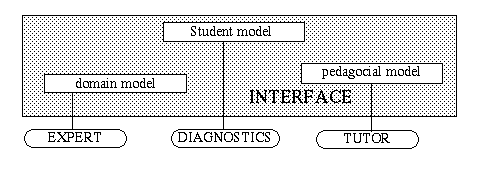Intelligent tutoring system: Difference between revisions
m (→References) |
m (→References) |
||
| Line 52: | Line 52: | ||
[[Category:Educational technologies]] | [[Category:Educational technologies]] | ||
[[Category: Artificial intelligence]] | |||
Revision as of 17:05, 8 August 2008
See also: Artificial intelligence and education (AI&Ed), a set of subfields in educational technology intrested by artificial intelligence technology in education.
Definition
- An Intelligent Tutoring System (ITS) replaces a human tutor by a machine. In most cases, it's "intelligent" CBT.
- Research in ITS organizes the "problem" in (1) knowledge about a domain, (2) knowledge about the learner, (") and pedagogy (knowledge of teaching strategies). The major components of a typical ITS are therefore an expert (or domain) model, student model and tutoring model. The expert model should be able to solve the problems the tutoring module submits to the students. The tutor module controls the interaction with the student, based on its teaching knowledge and comparisons between the student model and the domain knowledge. The student model reflects what the machine can infer about the student's cognitive state.
- Most ITS are implemented with expert system technology (in particular so-called production systems that in turn were based on research on human knowledge representation and corresponding computer models.
History
Intelligent Tutoring Systems (ITS) came into existence in the mid-seventies and had their peak time in the late eighties at the same time when expert systems were in vogue.
During the nineties, most research in artificial intelligence and education, rather focussed on intelligent learning environments more influenced by CBL, microworlds, etc. than CBT.
Although ITS research is not dead today, such system were not cost effective enough to survive in training. In aiddition, building an intelligent system is really tough, e.g. student modelling and user interaction are research problems by themselves. However, the major reason why most researchers moved on (e.g. to CSCL) is best explained by a longer quote from Reeves 1998:
- ITS attracted much more attention, funding, and research a few years ago than they do today. One telling sign is that the Journal of Artificial Intelligence in Education recently changed its name to the Journal of Interactive Learning Research. Even those who have been most involved in research and development targeted at producing "intelligent tutors" have begun to acknowledge the lack of impact they have had on mainstream education (Lajoie & Derry, 1993). A major factor contributing to the lack of success of ITS is that the technical difficulties inherent in building student models and facilitating human-like communications have been greatly underestimated by proponents of this approach.
- In the face of the disappointing results of ITS, some experts suggest that "...the appropriate role for a computer is not that of a teacher/expert, but rather, that of a mind-extension 'cognitive tool'" (Derry & Lajoie, 1993, p. 5). Cognitive tools [...] are unintelligent tools, relying on the learner to provide the intelligence, not the computer. This means that planning, decision-making, and self-regulation are the responsibility of the learner, not the technology. Cognitive tools can serve as powerful catalysts for facilitating these higher order skills if they are used in ways that promote reflection, discussion, and collaborative problem-solving [...].
Links
See artificial intelligence and education for pointers to journals and associations.
References
- Derry, S. J., & Lajoie, S. P. (1993). A middle camp for (un)intelligent instructional computing: An introduction. In S. P. Lajoie & S. J. Derry (Eds.), Computers as cognitive tools (pp. 1-11). Hillsdale, NJ: Lawrence Erlbaum.
- Lajoie, S. P., & Derry, S. J. (Eds.). (1993). Computers as cognitive tools. Hillsdale, NJ: Lawrence Erlbaum.
- Reeves, Thomas C. (1998), The Impact of Media and Technology in Schools, A Research Report prepared for The Bertelsmann Foundation, PDF
Here is a list of readers, books or articles that provide introductions:
- Costa, E. (Ed.) (1992). New Directions for Intelligent Tutoring Systems (pp 15-27). Berlin: Springer-Verlag.
- Goodyear, P. (Ed) (1991). Teaching knowledge and intelligent tutoring. Norwood (NJ): Ablex.
- Mandl and A. Lesgold (Eds) (1988), Learning Issues for Intelligent Tutoring Systems. New York: Springer Verlag.
- Self, J.A. (1986) The application of machine learning to student modelling. Instructional Science, 14, 327-338.
- Sleeman D.H. and J.S. Brown (Eds.) (1998) Intelligent Tutoring Systems. Academic Press, London.
- Wenger, Etienne (1987). Artificial Intelligence and Tutoring Systems. Morgan Kaufmann, Los Altos, CA, 1987. This probably remains the best book in the area, although it contributed to a paradigm shift from ITS towards cognitive tools.
